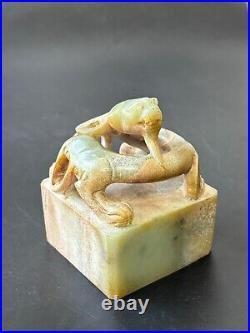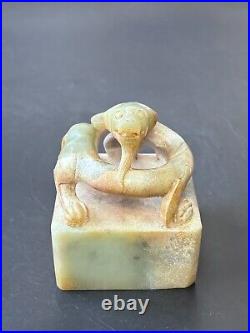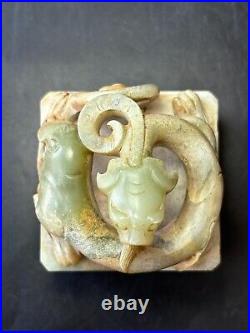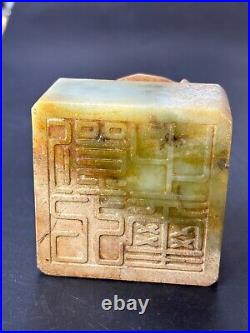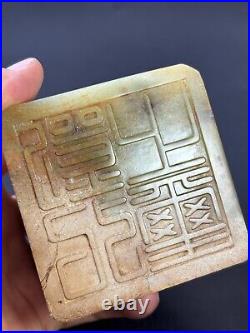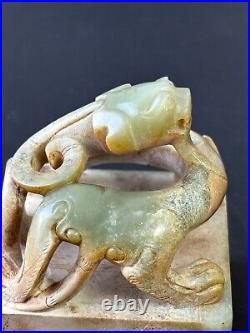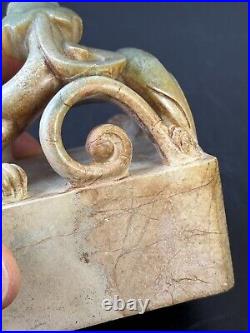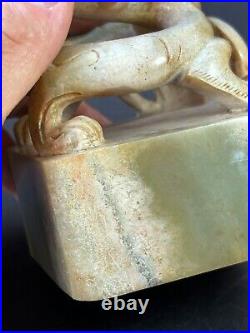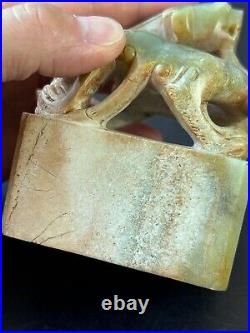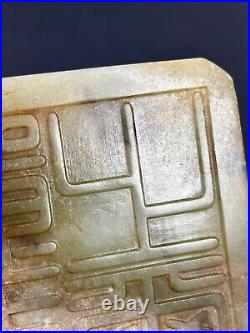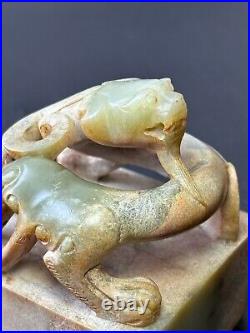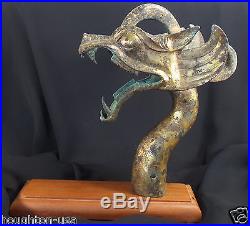


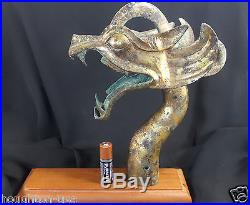
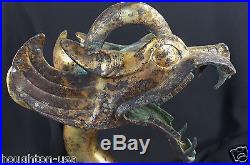

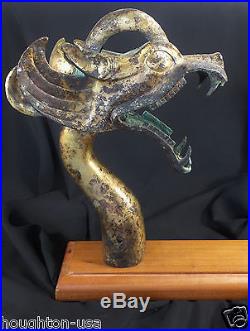
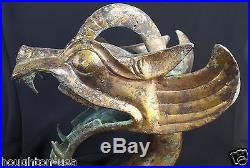
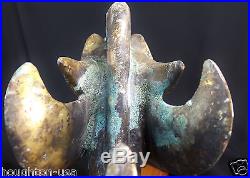



Antiques, Artifacts & Fine Collectibles. Gilt-Bronze Dragons Head Scepter. Generals or Warlords War Chariot Scepter. Partial Translation of Ancient Characters. Eastern Zhou DynastyWarring States Period. A Dragon can be unseen or visible, minute or huge. However, always it is great. Item: Chinese Gilt-Bronze Dragons Head War Chariot Scepter. Cast Gilt-Bronze Alloy with Mercury Gilding. 8 (200 mm) tall x 6.6 (160 mm) wide 3.2 x 3.2 (80 mm) thick. Eastern Zhou Dynasty to Warring States Period. This hollow, gilt-bronze Dragon Scepter is in museum quality condition. This artifact shows bronze oxidation under the gilt/gold finish. The gilt-bronze surface shows blisters from the oxidation of the bronze. It has deposits and red, green, and blue oxidation of the bronze that was buried for millennia in damp soil rich in cuprite, malachite, and azurite. Close examination with a microscope under natural and black light reveal it to be 100% authentic. Please look at the photos yourself and you will see the authentic details of this piece. Ex private collections in Henan, China; Hong Kong; & Washington State, USA. First time for sale in the United States. This fierce, gilt-bronze, Dragons Head would have been mounted on an ancient Chinese generals war chariot as a symbol of his great power. The Dragons head would have been mounted on a wooden pole that was attached to the generals observation chariot. The fantastic Dragon scepter is believed to have been part of the chariot furnishings of a warlord or general that lived over 2,000 years ago. It is in museum quality condition and EXTREMELY RARE! The Dragons gaping mouth is wide open and shows his four, vicious fangs as well as his back teeth. His curling ears and beautifully curved wings and his single crest are spectacular! Early depictions of Chinese dragons, like this amazing gilt-bronze scepter, has just one crest, while later versions up the present usually have two horns or crests. Just imagine what an image this fierce gilt-bronze dragon would have made as a warlord commanded his vast army into battle; the Sun rays striking this shinning, gold Dragon as it was displayed on the warlords personal chariot! During the Eastern Zhou Dynasty, war chariots with bronze fittings and ornaments like this Dragons head were pulled by two or four horses were used in battle and as observation posts for the leaders during the Warring States Period of the Zhou Dynasty. Chariots were also used in royal processions, to transport the royalty and nobility, and for the hunting expeditions of the elite, noble class. With the arrival of the Spring and Autumn Period (771-476 BCE) improvements had been made to the chariots design and construction. Over the centuries, these War Chariots were variously referred to as Gold Chariots. The Chinese War Chariot was a symbol of power as well as prestige among Chinese warlords, who often could boast an army of more than 1,000 chariots. Warlords would authorize the making of molds and the casting of bronze fittings like this lovely gilt-bronze Dragon scepter. The size and number of bronze items one could own or have placed in their tombs upon their death was strictly controlled by the ruling class. The Chinese ancestors believed that the design and display of symbolic, bronze decorations like this Dragon Scepter could communicate with divinities, determine the outcome of battles, and also frighten Evil Demons as well. Therefore, to enshrine the bronze ware in the temple or tomb would do something good to them either bring them good luck or ward off evil spirits. This bronze Dragon Scepter was beautifully cast in a piece mold using the section-mold casting technique and then polished smooth. It would have likely only been in a chariot for a warlord, general, or other high-level commander. There are several very small and faint Kuwen (seal script) ancient Chinese characters cast on the underside of the Dragons chin and his neck, but the characters are too faint for me to read as the bronze oxidation has obscured the characters. I can see what appear to be the following characters: ruler/king, a mans name, war chariot, and head/helmet. The small, round hole at the bottom of the scepter was designed for a wooden or bronze pin that would have securely attached the scepter to a wooden chariot pole. The bronze head is gilded and engraved with inscriptions that are hidden in some areas by the patina (green copper corrosion that forms on bronze). Mercury gilding was invented in China around the 5. Gold powder and mercury were mixed together to form a paste (also called an amalgam). The paste was applied to bronze or silver surfaces and heated. The mercury would vaporize with heat, leaving a thin layer of gold that was then burnished to give a smooth, shiny, gilded surface. This war chariot ornament was probably uncovered in a horse pit and not in a persons individual tomb. Horse pits are underground chambers located outside the main tomb of the deceased. Members of the royalty, military warlords, and nobility sometimes had their horses and chariots buried as a sign of their status and to assist them in their afterlife. This fabulous gilt-bronze dragon scepter was almost assuredly the personal property of a military warlord or general. Dragon Symbolism in China. In China the Dragon (in Chinese Long) has for millennia been the symbol of the Emperor, the Son of Heaven, eternity, Yang and Yin, as well as for male vigor and fertility. The Dragon is considered as one of the 12 Ornaments and one of the most complex and multi-tiered Chinese symbols. The Chinese dragon is a good natured and benign creature that can fiercely protect one from Evil Spirits and harm. The fierce, Dragon Head suggests that it symbolized the power of its owner as well as a talisman to scare away Evil Spirits and to bring good luck in battle. Bronze in Ancient China. In ancient China, bronze items played an important role in ceremonies and rituals for rulers and high officials. The ritual books of ancient China minutely describe who was allowed to use what kinds of bronze items in their daily lives and in their tombs, as well as specifying in what size and quantity. Have been discovered that contain over 2,000 bronze items that weigh as much as 20 tons! Bronze production was carefully controlled by the emperor and bronze vessels and items were meant only for the elite aristocracy and their immediate families. The Chinese inscribed all kinds of bronze items with three main motif types: demons, symbolic animals, and abstract symbols. The creation of magnificent bronze items was highly labor-intensive, and therefore its use was confined to that of the most important rituals of ancient Zhou kings, generals, and aristocrats. The oldest Shang dynasty vessels were used in rituals centered on the sacrificial offering of food and wine to ancestors. Like elaborate banquets for the dead, foods which included meats and grains as well as rice or millet wine and sacrificial water were prepared and presented in bronze vessels and then ritually offered at family altars, often located in a separate structure within a family compound. As British scholar, Jessica Rawson, explains. These were essentially family ceremonies in which both the dead and the living took part. The dead remained an integral part of everyday society, requiring the kind of attention also given to living members of the family. The banquets or rituals were a show of respect to the dead so as to ensure that they would help their descendants by interceding on their behalf with the gods and spirits. Without help from the dead, and a proper acknowledgement of their role, human affairs might fail and their descendants suffer. This was especially so of warlords and kings, whose ancestors not only had the power to affect the fortunes of their descendants, but were semi-godlike, having power and influence over the entire population as well. Thus the most elaborate rituals– more like ceremonies of state than the private rituals held by aristocratic families– were performed by ancient kings. Highly decorated bronze items played a leading role in these rituals– containing sacrifices and hosting their preparation. The Chinese ancestors believed that the design of the ornaments could communicate with divinities and frighten demons as well. Museums and modern archaeological studies usually use the general term copper alloy instead of just the term bronze to describe these ancient treasures, as many other elements (such as tin, lead, zinc, iron, and even arsenic) were added to the copper to form different strengths of types of bronze items. Ancient bronze artifacts such as this gilt-bronze scepter are probably about 80% copper and 20% tin, while modern bronze is closer to 88% copper and 12% tin. About the time this piece was gilded. This gilt Dragon Scepter has a beautiful, old patina with signs of oxidation of the two main elements (tin and copper) that make up this exquisite gilt-scepter. One interesting property of bronze is that once it has oxidized superficially, a copper oxide layer is formed on the surface and essentially protects the object from further damaging corrosion. This protective layer turns in another compound, called copper carbonate for you scientists, that protects most bronze pieces from even corrosive saltwater. It has a wonderful old, patina that is absolutely fabulous: a greenish patina from the malachite in the surrounding soil, some dark red patina from the cuprite in the soil, and a bright blue color that is from the azurite in the soil. This combination of colors forms a fantastic patina that is typical of bronze that has been buried for over 2,000 years. Close examination with a microscope under natural and black light reveal it to be 100% authentic and cast by hand in a mold. I have carefully examined this item under 10x magnification and it also shows authentic and original signs of weathering and ground contact that help to further authenticate it as an ancient piece. You will not be disappointed! It is exceeding rare and museum quality ancient Chinese work of art. It is a wonderful piece and would look great displayed next to your other fine ancient Chinese jade and bronze pieces! Please examine the macro photos taken indoors, as they are part of the description. I obtained this amazing War Chariot Fitting directly from a dealer in China and I Guarantee it to be original and authentic. This is the first time it has been for sale in the United States, as it was previously in a private collection in China and then Hong Kong. It has a wonderful, old, bronze and greenish patina (from the malachite in the surrounding soil) that is typical of bronze that has been buried for over 2,200 years. Close examination with a microscope under natural and black light reveal it to be authentic. It has a wonderful old, patina that is absolutely fabulous: a greenish patina from the malachite in the surrounding soil, and some dark red patina from the cuprite in the soil. Close examination with a microscope under natural and black light reveal it to be 100% authentic and cast by hand in a sand mold. The Great Bronze Age of China. An Exhibition from the Peoples Republic of China , edited by Wen Fong. Metropolitan Museum of Art, 1980. Archaeological Institute of America, Feb/March 2015. Iron and Steel in Ancient China. Shanghai Museum, Eastern Han Dynasty Bronze. British Museum, Eastern Zhou Dynasty, Gilt-Bronze Chariot Scepter on display. Lot 1270, Large gilt-bronze dragon head terminal fitting, Tang Dynasty, 9 3/4 inches long. Museum of Chinese History, Beijing. The Great Bronze Age of China , edited by Wen Fong, MET, 1980. Changhua Annals of the Republic of China (19111949). Smithsonian Museum, Sackler & Freer Gallery, WDC. This Gilt-Bronze Dragon’s Head Scepter is an EXTREMELY RARE Chinese artifact. Similar examples rarely come to market. It will come with a Certificate of Authenticity (COA) from Ancient Civilizations. It failed to sell. E-Bay never charges a buyers premium. Please examine the photos carefully, as they are an important part of the description. Free custom wood stand in photos is included. The AA battery is not included, just there to help you judge the size. All Sales are Final! The item “RARE Ancient Chinese Gilt-Bronze Dragon’s Head General’s War Chariot Scepter” is in sale since Friday, January 01, 2016. This item is in the category “Antiques\Asian Antiques\China\Statues\Dragons”. The seller is “houghton-usa” and is located in Sequim, Washington. This item can be shipped to United States.
- Color: Gold
- Type: Scepter
- Primary Material: Bronze
- Age: 770 BC — 221 BC
- Region of Origin: China
- Original/Reproduction: Original

